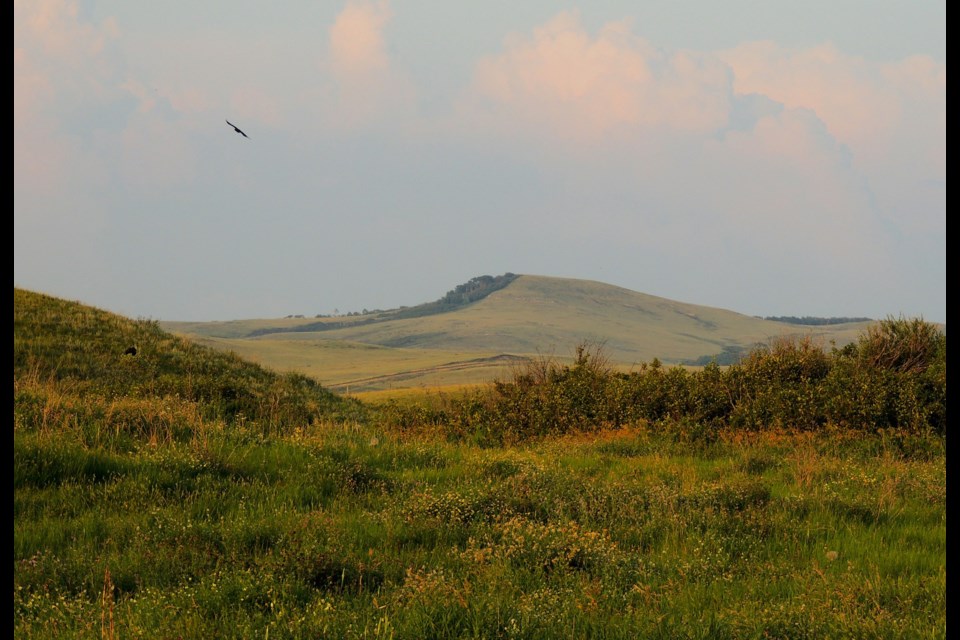ASSINIBOIA - A mile east of my home in the Wood Mountain Uplands stands a prominent land feature called Three Mile Butte. “Butte” pronounced “beaut,” is defined in the Collins Canadian dictionary as “a steep often flat-topped hill in Western Canada.”
Over the years our butte has undergone name changes depending on which cultural community was living nearby. The first people who built permanent homes here were more than 200 families of Metis who moved from Manitoba in the early 1870’s.
The book “Wood Mountain Uplands” by the Wood Mountain Historical Society (2000) states on page 23 “One settlement of Metis was located on the west side of the creek within the present site of the Wood Mountain Regional Park. Another was at Legare’s Coulee, three or four miles to the east.”
They named their new home “La Montagne de Bois”, French for Wood Mountain. Three Mile Butte may have been the inspiration for this name since a small forest of black birch trees covers its north face. Later names for the butte were Indian Cliff, Peppermint’s Hill and finally, Three Mile Butte.
Legare’s Coulee is the site of a trading post operated by Quebec-born adventurer Jean Louis Legare, established in 1871 and located 1 mile south of the butte. Our local history book, ”They Came to Wood Mountain” on page 8 informs us that “Legare established his store in a coulee three miles east of the Police Post.” (A coulee is defined as “a ravine cut by water in Western North America.”)
This Police Post was set up by the North West Mounted Police with the arrival of Sitting Bull and more than 4,000 Lakota Sioux following the Battle of Little Big Horn in Montana on June 25,1876. After four-and-a-half years Sitting Bull and most, but not all of his people returned to the U.S .
In his 2007 book “Frontier Farewell” Garrett Wilson discloses the site of Sitting Bull’s camp--- “the newly arrived Lakota moved in beside the camp of Minnesota Sioux under White Eagle living six-and-a-half km (four miles) east of the Boundary Survey buildings that became the NWMP Wood Mountain Post”(page 312).
Inspector James Walsh was in command and moved his headquarters here from Fort Walsh, 120 miles to the west. Many trips by horseback were made between the two posts and in a letter to his daughter Cora back in Ontario Walsh mentions a familiar landmark.
“Frontier Farewell”, page 342: “There was no such thing as feeling comfortably warm on one of those trips from the time Cypress Mountain was departed from until Wood Mountain was reached and you can imagine what joy it brought to every heart after five or six days through snow without water or fire when “Indian Cliff” in Wood Mountain on the butte, or “The Three Pines” in Cypress Mountain would be sighted, either of them affording a haven of rest”.
Three Mile Butte can be spotted with the naked eye from 15 miles to the west. It’s interesting that after he retired, Walsh bought a home in Brockville, Ontario and named it “Indian Cliff”. The Lakota Sioux who camped all around Three Mile Butte gave it the name “Peppermint’s Hill”.
Ron Papandrea wrote about those who remained forever in Canada in his 2007 book “They Never Surrendered.” On the very last page he quotes the words of John Okute LeCaine who he calls the “Wood Mountain Lakota Sioux leader and historian for his people” --- ”Look to the hills, southeast of the town of Wood Mountain and your eyes cannot evade one particular hill ... white pioneers have named this hill “The Three Mile Butte” but to Sitting Bull and his followers who made Wood Mountain their refuge, it was known by the name of “Peppermint’s Hill”. Many years ago upon this hill a warrior stood. His name was Peppermint ... in a loud voice he was pleading and praying for peace for his war weary people. Three days and nights without food or water he stands exposed to all the elements, pleading for a moment’s revelation.
Peppermint has vanished ... only remnants...ghosts of his kind you have seen ... Peppermint’s Hill alone stands today bearing these secrets ... and there it will stand...mystifying those who will follow us.” When the homesteaders arrived here they built a town they called “Wood Mountain” next to the Police Post. The tall hill they saw three miles to the east they named “Three Mile Butte,” the name used today.
In 1927 the town was moved four miles to the north to be beside the railway tracks. Like a lot of rural communities, it is slowly disappearing. The school has closed, as has the store and hotel and gas station, even the railway track has been pulled up. But Three Mile Butte continues to stand there, and in the words of John Okute LeCaine “there it will stand...mystifying those who will follow us.”




